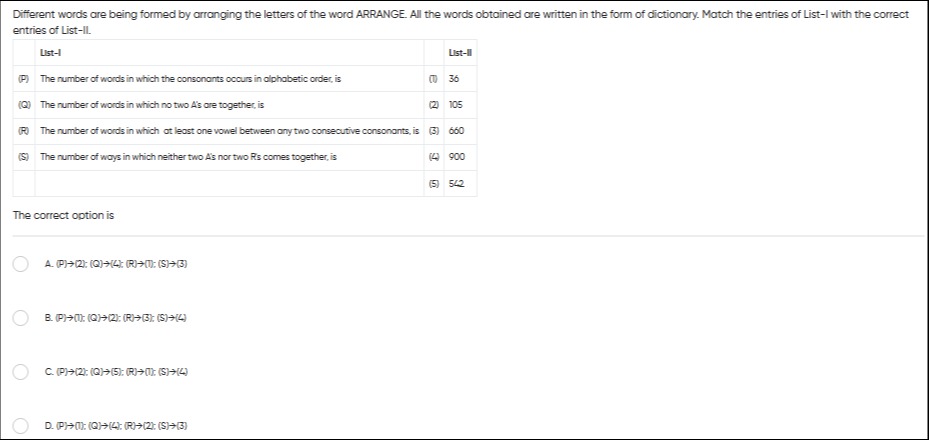Question
Question: Different words are being formed by arranging the letters of the word ARRANGE. All the words obtaine...
Different words are being formed by arranging the letters of the word ARRANGE. All the words obtained are written in the form of dictionary. Match the entries of List-I with the correct entries of List-II.
List-I: (P) The number of words in which the consonants occurs in alphabetic order, is (Q) The number of words in which no two A's are together, is (R) The number of words in which at least one vowel between any two consecutive consonants, is (S) The number of ways in which neither two A's nor two R's comes together, is
List-II: (1) 36 (2) 105 (3) 660 (4) 900 (5) 542

(P)→(2); (Q)→(4); (R)→(1); (S)→(3)
(P)→(1); (Q)→(2); (R)→(3); (S)→(4)
(P)→(2); (Q)→(5); (R)→(1); (S)→(4)
(P)→(1); (Q)→(4); (R)→(2); (S)→(3)
(P)→(2); (Q)→(4); (R)→(1); (S)→(3)
Solution
The word ARRANGE has 7 letters: A (2 times), R (2 times), N (1 time), G (1 time), E (1 time). Total permutations = 2!2!7!=1260.
(P) Consonants (G, N, R, R) in alphabetic order: Treat consonants as identical 'X'. Arrange A, A, E, X, X, X, X: 2!4!7!=105. The 4 'X's must be G, N, R, R in order (1 way). So, (P) → (2) 105.
(Q) No two A's together: Total words - (Words with AA together). Words with AA together: Treat AA as a block. Arrange (AA), R, R, N, G, E: 2!6!=360. Number of words = 1260−360=900. So, (Q) → (4) 900.
(R) At least one vowel between any two consecutive consonants (i.e., no two consonants together): Arrange vowels A, A, E: 2!3!=3 ways. These 3 vowels create 4 gaps. Place the 4 consonants (R, R, N, G) in these 4 gaps: 2!4!=12 ways. Total words = 3×12=36. So, (R) → (1) 36.
(S) Neither two A's nor two R's come together (no AA and no RR): Using Principle of Inclusion-Exclusion. Total = 1260. N(AA)=2!6!=360. N(RR)=2!6!=360. N(AA and RR): Treat AA and RR as blocks. Arrange (AA), (RR), N, G, E: 5!=120. N(AA or RR)=N(AA)+N(RR)−N(AA∩RR)=360+360−120=600. Number of words with neither AA nor RR = 1260−600=660. So, (S) → (3) 660.
The correct matching is (P)→(2); (Q)→(4); (R)→(1); (S)→(3).
